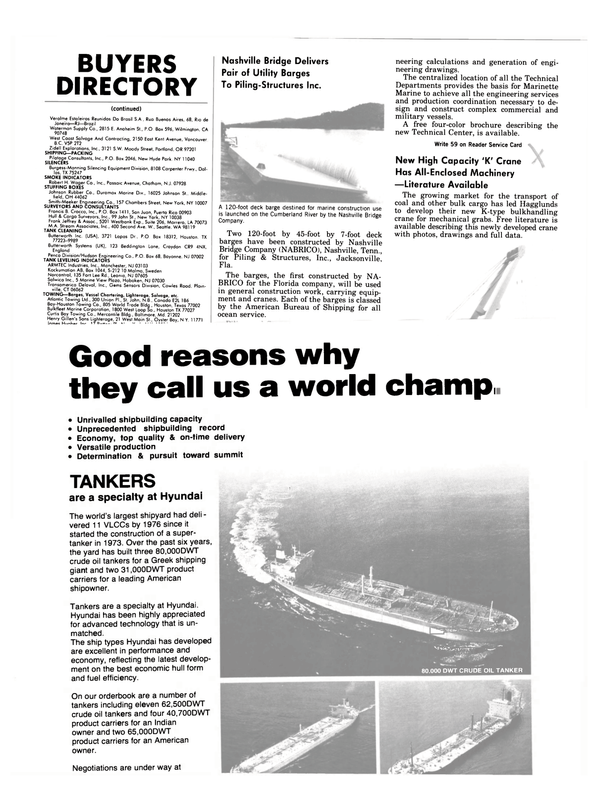
General Dynamics Building Cargo Transfer Platform Barge With National Jacking System
An offshore jacking system built by National Supply Company, Houston, will give "legs" to a cargo handling barge designed for shipping major marine components between New England shipyards.
The jacking system will enable General Dynamics' Electric Boat Division to load and unload components at dock level, then raise the legs and tow the barge between its shipyards in Groton and 50 miles up the coast at Q u o n - set Point, R.I.
Also described as a "cargo elevating platform," the barge will be 195-feet long and 78- feet wide with a capacity of about 1,200 tons.
The barge is expected to make about 25 trips a year between the two shipyards with components weighing up to 600 tons.
National's jacking system was developed for the offshore oil industry. Drilling or production platforms fitted with the jacking system could be towed to an offshore oil field. Then the legs would be jacked into place to create a stable platform in varying water depths. The legs could then be easily retracted whenever the platforms needed to be towed to a new location.
Bruce Dawson, sales engineer for National's Drilling Equipment Division, Houston, said the rack-and-pinion jacking system consists of three independent jacking units and legs. Each cylindrical leg, fitted with a sawtooth rack, is 72 feet in length, with an outside diameter of six feet.
"The system is electrically controlled and can be powered from shore-supplied power sources," added Mr. Dawson. "The electrical system provides smooth and continuous movement for the precise adjustment of the platform to the docks in a minimum amount of time." The barge loading and jacking system idea grew out of a brainstorming session at Gen- eral Dynamics. Cranes used in recent years had been limited to 300 tons and the Electric Boat Division sometimes wanted to transport far larger components.
The jacking units were manufactured at National Supply Company's plant in Torrance, Calif., and the legs and racks were made in Houston. The equipment was then shipped to Quincy, Mass., where the barge is being constructed by General Dynamics' Quincy Shipbuilding Division.
National said the barge jacking system should find an easier service life than those used on many offshore installations.
"We're really looking at an ideal situation here because loading and unloading will be done in protected areas on concrete pylons and under good weather conditions," he said. By comparison, some offshore jacking system legs used on drilling rigs are longer than a football field and are expected to withstand severe pounding from ocean waves and high winds.
Mr. Dawson said jacking systems can be used for other non-oilfield purposes—such as portable drydocks, bridge erection and pile driving.
For free literature on National Supply's offshore jacking system, Write 9 4 on Reader Service Card
Read General Dynamics Building Cargo Transfer Platform Barge With National Jacking System in Pdf, Flash or Html5 edition of October 1983 Maritime Reporter
Other stories from October 1983 issue
Content
- Jeffboat Building Three Title XI Approved Cruise Vessels Worth $28-Million page: 4
- Tacoma Boat Completes $143-Million Financing To Build Two Thai Corvettes page: 5
- Blue Star Line To Add Four New Reefer Ships page: 5
- Centrico Forms New Mineral Oil Group Headed By Lohmeyer page: 5
- Joint Venture Receives Title XI For $109-Million Chemical Carrier page: 6
- COMSAT World Systems Division Announces Three Vice Presidential Changes page: 7
- National Steel Receives $13-Million Order To Overhaul The U.S.S. Cayuga page: 7
- Title XI Approved On $24-Million Package For Puget Sound Tug & Barge page: 8
- Lamberts Point Barge Title XI Approved For $20-Million Coal Barge page: 8
- E U R O P O R T ' 83 page: 8
- MARCO Pacific Shipbuilding Formed In Taiwan page: 9
- St. Louis Ship Delivers 6,000-HP Towing/Supply Boat To Gulf Fleet Marine page: 10
- Construction Of Two RAN Minehunters Progressing At Carrington Slipways page: 12
- FISH EXPO '33 page: 14
- Marine Coating Directory Is Offered By Farboil page: 19
- Radm. Meyer Receives New Assignment page: 20
- B&W Diesel Acquired By American M.A.N. page: 21
- Emergency Medical Course Offered By Marine Safety page: 21
- National Marine Opens New Facility In Norfolk page: 22
- $19.9-Million Contract Awarded Tracor By Navy page: 22
- Icebreaking Supply Vessel M/V Miscaroo Delivered By Vancouver Shipyards page: 22
- Apelco Relocates To Tampa, Names Vourloumis New Marketing Manager page: 23
- Hydranautics Shiplift Commissioned At Hyundai page: 23
- Terry To Manufacture And Sell AEG-Kanis Steam Turbines In North America —Literature Available page: 24
- High-Speed Supermaran Ferry Marine Hawk Enters Service page: 24
- M/V GRAND REPUBLIC page: 26
- NATO FRIGATES Current Situation And Future Design Trends page: 26
- Harris Awarded $12-Million WATERCOM Telephone Contract page: 32
- Environmental Systems Changes Name To Electrolux Envirovac page: 32
- Soviet Merchant Fleet Now 'Blankets The Globe' page: 33
- Drilling Rig Dry Transport Cuts 11,000-Mile Sailing Time In Half page: 34
- Notional Supply Advances Ayers To Product Manager page: 34
- Wijsmuller's First 'Mighty Servant' Heavy-Lift Carrier Is Commissioned page: 36
- Nichols Brothers Launches M/V Tiny page: 36
- CDI Marine Announces Management Reorganization page: 38
- Daewoo Delivers $74-Million Offshore Rig page: 39
- Change In Personnel Licensing Regulations For Commercial Ships Sought By U.S. Coast Guard page: 40
- Moss Point Marine Delivers 'Nicor Power' To Nicor Marine page: 40
- Marathon Oilfield Service Offers Color Brochure On Rigs And Resources page: 41
- Bath Iron Appoints Four New Directors page: 41
- Hitachi Announces Top Management Appointments page: 42
- Burrard Yarrows Delivers Icebreaker/Utility Vessels To Gulf Canada Resources page: 42
- NKK To Build Mobile Drilling Island For Beaufort Sea Project page: 42
- Peterson Builders Offers 56-page Review Of 50 Years Of Boatbuilding History page: 43
- Tenneco In Joint Venture To Operate Its Own Service Boats In Gulf page: 43
- McDermott Derrick Barge 27 Upgraded to 2,400-Ton Lift page: 47
- USCG Gentian Recommissioned After $8.3-Million Renovation page: 47
- Navidyne And Medical Advisory Systems Provide Free Introductory Medical Service page: 47
- Twin City Shipyard Delivers Split Hull Barges To Panama page: 49
- Wartsila AB Delivers LPG/Ammonia Tanker To Maraven In Venezuela page: 49
- Daewoo Employs Unique Floating Drydock And Ship Transfer System page: 49
- Blount Marine Delivers Star of Chicago To Star Line Corporation page: 53
- 380-Foot Drillship To Be Auctioned In Singapore page: 54
- General Dynamics Building Cargo Transfer Platform Barge With National Jacking System page: 54
- Nashville Bridge Delivers Pair of Utility Barges To Piling-Structures Inc. page: 58


